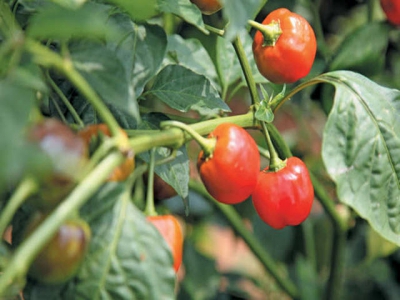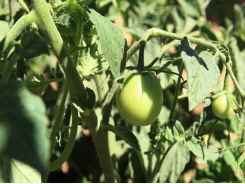Success with sweet piquanté peppers

Sweet piquanté peppers, marketed under the PEPPADEW label, require all the attention a farmer can spare to produce good results. Limpopo farmer, Jaco Kriel, spoke to Gerhard Uys about producing this challenging but rewarding crop.
Peppadew International, the South Africa-based processor, distributor and exporter of sweet piquanté peppers, supplies farmers with seedlings, and farmers then produce peppers on contract with an offtake price determined before planting commences. Photo: Gerhard Uys
Jaco Kriel is a highly diversified farmer near Vaalwater in Limpopo. An agricultural consultant for eight years, he went on to become a grape and ostrich farmer, but today focuses on breeding Bonsmara cattle and growing seed-maize, peanuts, dry beans, and sweet piquanté peppers.
Although the latter may be one of many enterprises in his operation, Jaco admits that this crop requires more than its fair share of attention to grow successfully.
Sweet piquanté peppers are a cultivar of chilli pepper (Capsicum baccatam).
The fruit is trademarked under Peppadew International, the South Africa-based processor, distributor and exporter of the fruit.
Jan supplies the company directly. He plants between 10ha and 12ha of his 100ha to this crop.
“When a farmer wakes up in the morning, he should think about how to expand his operation or improve production. He won’t survive otherwise. I couldn’t add to my lands, so had to produce more intensively. Some farmers in the area had already planted sweet peppers, so I contacted them,” Jaco recalls.
Climate, soil & terrain
The average rainfall in the Vaalwater area is around 650mm, but in the past few seasons below-average rainfall was recorded. Sweet piquanté peppers require irrigation, with plants needing 5mm/ha/day from drip irrigation at peak harvesting time.
“One cannot plant it as a dryland crop as it requires adequate water. I planted under centre pivot last year, but this wasted water because the rows were too far apart.
“This year I used drip irrigation, which seems to be the most effective,” Jaco says.
The soil in the Vaalwater area is mainly avalon and sandy lime, and although this is not the ideal soil for the crop, Jaco aims to harvest around 25t/ha.
Peppers are particularly sensitive to cold, and frost can destroy an entire crop. Low temperatures also result in wrinkled fruit, which is rejected by Peppadew International. For these reasons, Jaco plants the crop in the warmer areas of the farm.
Production
Jaco takes soil samples of every hectare before planting, and adjusts lime and phosphate levels based on results. “Farming is a science, and competition is tight,” he says. “We cannot farm the way our grandfathers did.”
After the soil is adjusted, Jaco follows Peppadew International’s prescribed fertilising programme.
Sweet piquanté peppers require rotation with crops such as maize. Vegetables or tomato-type plants are not ideal as they attract the same pests that sweet piquanté peppers are susceptible to.
Peppadew supplies its producers with seedlings, which are then planted by hand or mechanised planters in September. Jan plants these 300mm apart in the row, and at an inter-row spacing of 2m, which works out at a density of 17 000 plants/ha.
Sweet piquanté peppers are perennial, and will continue flowering if temperatures remain above 13˚C. But Nico Kotze, an extension officer at Peppadew International, says that plants should be slashed and worked into the soil again, and new seedlings planted every season. The reason is that plants kept for regrowth tend to produce substandard fruit.
Harvesting
The peppers are ready for harvesting once fully coloured; at this stage, each weighs between 6g and 15g. The fruit is handpicked more or less weekly, as it matures between mid-January and the end of May, and twice a week during peak harvesting season. At this stage the task is highly labour-intensive, requiring eight labourers per hectare.
Peppadew International grades fruit as choice or standard grade. Different grades are sold in different markets. All fruit is required to be of exceptional quality, and, if bottled, must be the same size.
Jaco recommends that inexperienced farmers first grow the crop on a limited scale to gain experience.
“Take an established farming enterprise and expand it. Don’t make sweet piquanté peppers your main source of income when you start out – get to know how to manage irrigation, fertilising and labour.”
Some farmers suggest starting with just 2ha or 3ha, but Jaco believes that this is too little, as other crops will invariably take priority. He suggests 8ha to 10ha, as this “forces the farmer to make a success of it”.
“It’s a high-risk crop; if you don’t manage it properly, you won’t produce a good harvest.”
Pests, weeds & water
For an intensive crop, sweet piquanté peppers have relatively few diseases and pests, with bollworm and fruit fly being the main concerns. A fungicide programme is therefore essential.
Calcium shortages can lead to blackspot, but foliar supplements can prevent this problem.
When the harvest season commences, Jan administers potassium and nitrogen weekly via drippers.
Providing enough water is crucial, he stresses. “Because this is an intensive crop, one can’t fix mistakes after the fact. For example, I realised with the drought that sweet piquanté peppers need water regularly.
I tried to keep all the plants alive by reducing their water to the bare minimum, and suffered huge losses. It’s better to sacrifice some plants and make sure that a portion of the plants receive all the water they need.”
Irrigation management is particularly important because peppers are grown for eight months before harvesting, as opposed to four for other crops.
Weed control has to be done early on and by hand as few suitable herbicides are available.
Jaco advises that a farmer should persevere with peppers (as with any crop) if the first harvest is unsuccessful. Giving up means that the lessons learned in the first year are wasted.
Related news
Tools

Phối trộn thức ăn chăn nuôi

Pha dung dịch thủy canh

Định mức cho tôm ăn

Phối trộn phân bón NPK

Xác định tỷ lệ tôm sống

Chuyển đổi đơn vị phân bón

Xác định công suất sục khí

Chuyển đổi đơn vị tôm

Tính diện tích nhà kính

Tính thể tích ao



 China still key market for Vietnamese farm produce
China still key market for Vietnamese farm produce  Internal, external factors challenge Vietnam’s coffee exports
Internal, external factors challenge Vietnam’s coffee exports